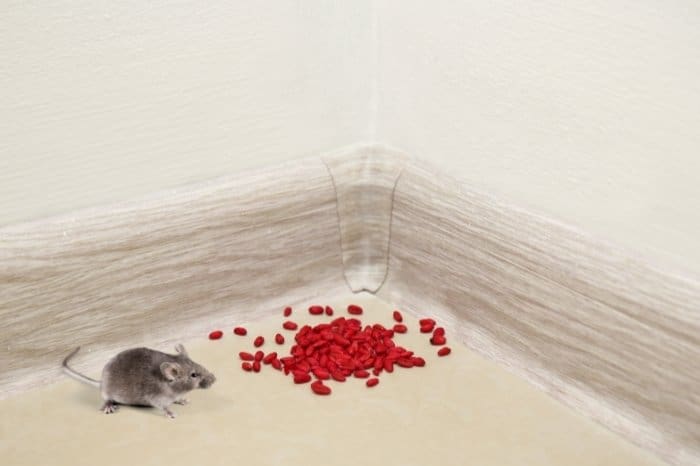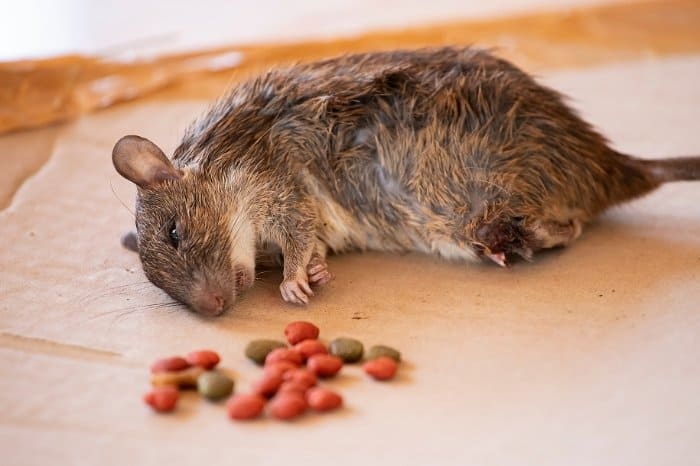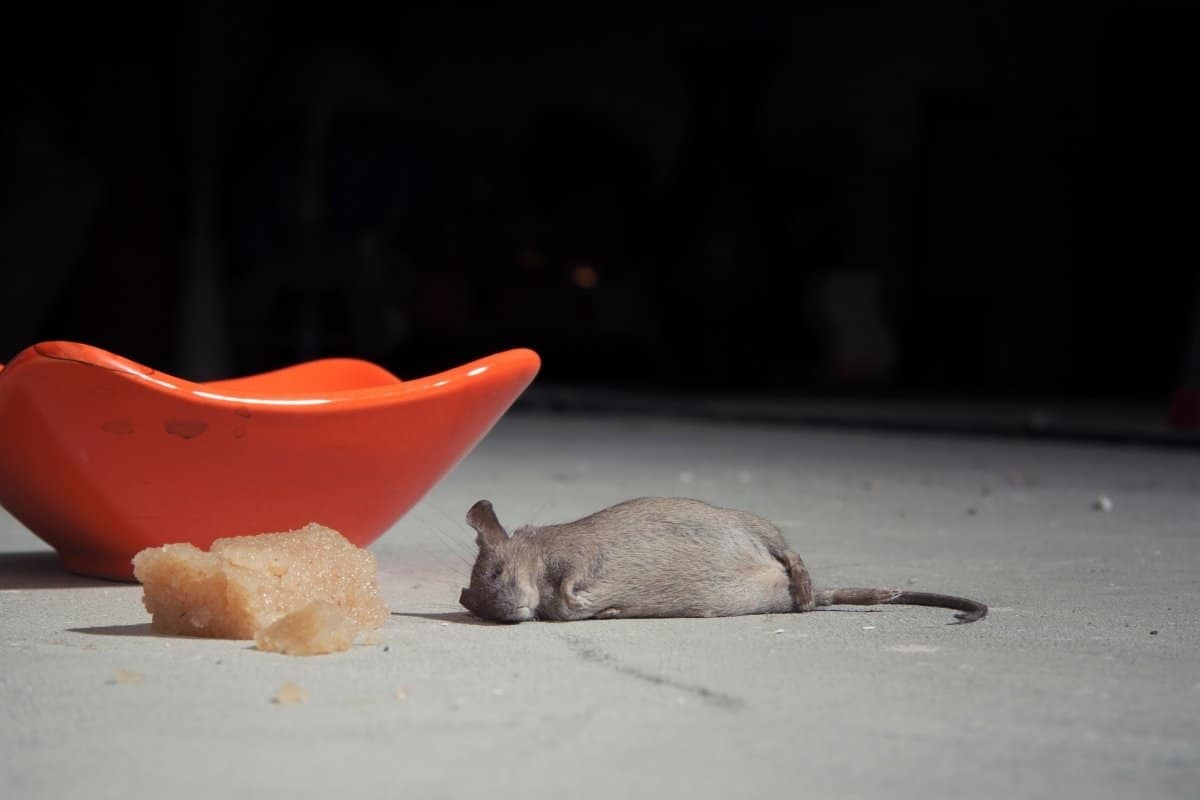Last Updated on February 14, 2022 by
Blue death mouse poison is commonly used to eliminate mice and rodents. Also known as rodenticides, it is highly toxic and effective.
They are made of multiple active ingredients that are highly toxic to all animals and humans too. Exposure to these chemicals should be kept at a minimum because they are dangerous and could lead to organ failure, internal bleeding, paralysis, coma, and death.
What Is Blue Death Mouse Poison?
Generally, rat poison compiles anticoagulants, better known as blood thinners, responsible for more than 50% of rodenticide-related deaths each year.
In the 1950s, the first rat poison, warfarin, hit the market; unfortunately, rodents quickly became resistant to it. As a result, super-strong rat poisons were created with more prolonged effects, and they are 100 times more toxic.
The two superheroes responsible for most of the rodenticide poisonings in humans are bromadiolone and brodifacoum.
Blue death mouse poison is among the rat poison products that contain blue or green dye to help quickly identify them when a pet or a child touches or consumes them. This helps save life soon because you can be able to tell what one has ingested.
This blue rat poison is also easily identified when you keep it in the area you target the mouse to keep any humans or pets away from it.
Among the many brands of rat poison available in the market today, you are likely to encounter these brands as some of the most effective in rat poison.
- Tomcat Bait Chunx: It contains bromethalin and is administered as a single-dose pesticide – this only needs to be ingested once, and the mouse is dead.
- Havoc Rodenticide Bait: It contains brodifacoum and is an anticoagulant pesticide
- Bell Contrac Rodent Control: an anticoagulant that contains bromadiolone
- Neogen Rodenticide: This anticoagulant has diphacinone
- ZP Tracking Powder: This indoor rodenticide contains cholecalciferol
What Is Blue Death? – Is It Related To Mouse Poison?
Blue death is a method that uses mouse poison to eliminate them. Poisons work well, especially when you are targeting many mice around the same area. If you have tried traps and the mice seem to know them and keep away, it’s time to eliminate them with the poison.
Modern poison formulas are based on either the anticoagulant properties or disruption of the nervous system. Once ingested by the mouse, the anticoagulant causes severe internal bleeding that causes the mouse’s strategy to go into shock and cause blood loss.

After consumption, the mouse feels no pain, but it succumbs within no time. This is known as blue death. In the blue end, the nervous system disrupts the rudimentary electronics of life, and it shuts down; the mouse is silenced once and falls.
These poisons are hazardous, and as you administer them, you must exercise caution. Keep the pets, children, and other wildlife away, so they don’t consume them. Wear gloves always when distributing the poison, and wash them with soap and water afterwards.
Check Out How To Get Rid Of A Possum – Opossum Control
How Rat Poison Works
Almost all rodenticides in the market comprise anticoagulant compounds. After the rat ingests this poison, it prevents blood from clotting resulting in excessive internal bleeding.
Some rat poisons are lethal after only one exposure, while others require multiple doses to kill. It usually takes 4 to 14 days of a rodent feeding on them for death to occur.
Secondary poisoning is an issue that primarily affects pets, wildlife, and farm animals as well. An example of this is when a pet cat eats a mouse that has already been poisoned using rodenticide.
Tomcat With Bromethalin Bait Chunx Pail
Here’s How They Work
- Bromethalin is a neurotoxin causing cell death in the central and peripheral nervous systems. If a pet consumes bromethalin, it may experience signs like vomiting, seizures, losing control of its legs, or get into a coma. This occurs at least 8 to12 hours after consumption.
- Anticoagulants cause internal bleeding that goes unnoticed for several days after exposure. Pets that have ingested include trouble-breathing, seizures, lethargy, shaking, bleeding from the gums, bloody stool, and abdominal swelling.
- Zinc Phosphide is a substance that turns into gas after consumption. It cripples the body’s major organs. Toxicity signs in pets include pacing, anxiety, weakness, and convulsions 4 to 18 hours after exposure.
- Cholecalciferol is a form of vitamin D leading to calcium toxicity, heart failure, and kidney damage. Signs of poisoning include vomiting, loss of appetite, frequent urination, and depression from 12 to 36 hours after exposure.
- Strychnine is a compound that triggers severe seizures that inhibits breathing. In animals, seizures are the primary symptom, and they start 15 minutes to 2 hours after exposure.
Ingestion is not the only form of exposure for these rat poisons. Warfarin, one of the most poisonous death mouse poisons, is the only one that is highly toxic when either inhaled or ingested. Warfarin is also highly toxic when ingested and has low toxicity associated with touching or breathing it.

Note that Diphacinone, bromadiolone, brodifacoum, and bromethalin are toxic to the touch and quickly absorbed into the skin.
Be careful to protect your eyes when working with rodenticides. Most of them can cause mild to moderate eye irritation.
FAQs
How long do mice take to die after eating poison?
The time from ingestion of a toxic dose to death is very variable. It depends on the amount ingested, and the type of poison ingested (oral, inhaled, injected, etc.). For example, in the case of sodium cyanide, it can take anywhere from 20 minutes to 2 hours for symptoms to appear.
In contrast, cyanide compounds in general are very rapidly absorbed, even through the skin, so death can be immediate. Some of these poisons cause severe damage to the liver, kidneys, brain, heart and lungs. These are not all the ways to die, but they should give you an idea.
Where do mice hide during the day?
A mouse's home range is defined as its area of use, or the area that it visits frequently. This includes the territory it defends, and the areas within it where it stores food and other resources, such as a nest or shelter. In an open space like a large house or garage, a mouse's home range can be huge.
But in a small space, like a mouse's nest, the home range may be very limited. In the wild, a mouse's home range is typically larger than its territory because there are many mice in a group, so a single mouse does not have to defend a large territory.
What time do mice come out night?
The answer is that mice are nocturnal animals, and are active at night. However, they will come out for a little while during the day if there's food around (or if it's been raining). In general, the mice start to come out around 10:00pm and they are still in the house until about 5:00am.
Will mice leave if no food?
Yes, mice will usually leave on their own if food is not available.
Do mice always come back?
Yes, they do. Mice are small mammals that live in a large number of environments, from the wild to urban areas. The animals have a lifespan of around two years and they reproduce quickly. Their population is very high, so they can be found everywhere. They are very small and their main characteristic is their speed. They can move with great precision and can be very aggressive.
Whats the fastest way to get rid of mice?
You can put poison in their food. It will take them longer to die because they will eat it. But it is very quick and humane. I would use a poisoned mouse trap if you can find one. Otherwise, you can try making your own. Get an empty plastic bottle (or other wide-mouth bottle) and a funnel.
Put the funnel in the bottle with a small amount of the poison in the bottle. The bottle should be closed tightly. You can leave the bottle in a dry place. You will know when the poison works because the mice will not eat the food in the bottle. They will find some other way to get it. You can also try using a spray bottle.
ou can buy the poison from your local hardware store or pet shop. There are many different kinds. You can also make your own poison. Use a mixture of salt, pepper, garlic, onions, and hot peppers. Mix them together and put them in an empty bottle. Do not use anything that will burn or sting you. You can also put some of the mixture in a cup with water. The mice will drink it and die.
Conclusion
FAQs
How long do mice take to die after eating poison?
The time from ingestion of a toxic dose to death is very variable. It depends on the amount ingested, and the type of poison ingested (oral, inhaled, injected, etc.). For example, in the case of sodium cyanide, it can take anywhere from 20 minutes to 2 hours for symptoms to appear.
In contrast, cyanide compounds in general are very rapidly absorbed, even through the skin, so death can be immediate. Some of these poisons cause severe damage to the liver, kidneys, brain, heart and lungs. These are not all the ways to die, but they should give you an idea.
Where do mice hide during the day?
A mouse's home range is defined as its area of use, or the area that it visits frequently. This includes the territory it defends, and the areas within it where it stores food and other resources, such as a nest or shelter. In an open space like a large house or garage, a mouse's home range can be huge.
But in a small space, like a mouse's nest, the home range may be very limited. In the wild, a mouse's home range is typically larger than its territory because there are many mice in a group, so a single mouse does not have to defend a large territory.
What time do mice come out night?
The answer is that mice are nocturnal animals, and are active at night. However, they will come out for a little while during the day if there's food around (or if it's been raining). In general, the mice start to come out around 10:00pm and they are still in the house until about 5:00am.
Will mice leave if no food?
Yes, mice will usually leave on their own if food is not available.
Do mice always come back?
Yes, they do. Mice are small mammals that live in a large number of environments, from the wild to urban areas. The animals have a lifespan of around two years and they reproduce quickly. Their population is very high, so they can be found everywhere. They are very small and their main characteristic is their speed. They can move with great precision and can be very aggressive.
Whats the fastest way to get rid of mice?
You can put poison in their food. It will take them longer to die because they will eat it. But it is very quick and humane. I would use a poisoned mouse trap if you can find one. Otherwise, you can try making your own. Get an empty plastic bottle (or other wide-mouth bottle) and a funnel.
Put the funnel in the bottle with a small amount of the poison in the bottle. The bottle should be closed tightly. You can leave the bottle in a dry place. You will know when the poison works because the mice will not eat the food in the bottle. They will find some other way to get it. You can also try using a spray bottle.
ou can buy the poison from your local hardware store or pet shop. There are many different kinds. You can also make your own poison. Use a mixture of salt, pepper, garlic, onions, and hot peppers. Mix them together and put them in an empty bottle. Do not use anything that will burn or sting you. You can also put some of the mixture in a cup with water. The mice will drink it and die.
If you see rats living in your home, it’s best first to try to use natural deterrents like peppermint oil or rat traps before introducing rat poison.
Rat poison is highly toxic to animals and humans alike, whether touched, smelled, or ingested. It is best to avoid it by all means.
Rat poisoning can be lethal, but one major setback is that the symptoms do not always appear right away. Should any of your family or your loved ones come in contact with rat poison, do not wait for symptoms to show.
Take a clear picture of the rat poison package or carry it with you to the healthcare provider to see it. Go to the nearest ER right away and get help as fast as you can.
Poisons of any kind, even labeled non-toxic, potentially carry harmful effects if ingested by pets, adults, or kids. The best way to ensure your family’s safety is to keep all these poisons away from anybody’s reach. Lock them up in a lockable cupboard away from anyone.
Caroline is a gardener who loves to get down to the nitty–gritty of gardening. She proudly proclaims herself as a ‘dirt worshipper‘ and can often be found deep in the garden, covered in soil and singing to her plants. As a self–proclaimed ‘plant whisperer‘, Caroline believes that plants need love and attention just like any other living thing, and she loves to give them both. When she‘s not tending to her garden, you can often find her researching the latest gardening trends, or teaching others how to make their gardens thrive



